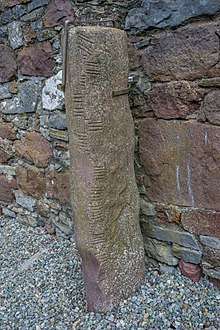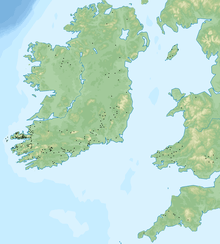Primitive Irish
| Primitive Irish | |
|---|---|
| Archaic Irish | |
 Ogham stone from Ratass Church, 6th century AD. It reads: [A]NM SILLANN MAQ VATTILLOGG ("name of Sílán son of Fáithloga") | |
| Native to | Ireland, Isle of Man, western coast of Britain |
| Region | Ireland and Britain |
| Era | Evolved into Old Irish about the 6th century AD |
|
Indo-European
| |
| Ogham | |
| Language codes | |
| ISO 639-3 |
pgl |
| Glottolog | None |
 Map with original locations of orthodox ogham inscriptions already found. | |
Primitive Irish or Archaic Irish[1] (Irish: Gaeilge Ársa) is the oldest known form of the Goidelic languages. It is known only from fragments, mostly personal names, inscribed on stone in the ogham alphabet in Ireland and western Great Britain from around the 4th to the 7th or 8th century.[2]
Characteristics
Transcribed ogham inscriptions, which lack a letter for /p/, show Primitive Irish to be similar in morphology and inflections to Gaulish, Latin, Classical Greek and Sanskrit. Many of the characteristics of modern (and medieval) Irish, such as initial mutations, distinct "broad" and "slender" consonants and consonant clusters, are not yet apparent.
More than 300 ogham inscriptions are known in Ireland, including 121 in County Kerry and 81 in County Cork, and more than 75 found outside Ireland in western Britain and the Isle of Man, including more than 40 in Wales, where Irish colonists settled in the 3rd century, and about 30 in Scotland, although some of these are in Pictish. Many of the British inscriptions are bilingual in Irish and Latin; however, none show any sign of the influence of Christianity or Christian epigraphic tradition, suggesting they date from before 391, when Christianity became the official religion of the Roman Empire. Only about a dozen of the Irish inscriptions show any such sign.
The majority of ogham inscriptions are memorials, consisting of the name of the deceased in the genitive case, followed by MAQI, MAQQI, "of the son" (Modern Irish mic), and the name of his father, or AVI, AVVI, "of the grandson", (Modern Irish uí) and the name of his grandfather: for example DALAGNI MAQI DALI, "[the stone] of Dalagnos son of Dalos". Sometimes the phrase MAQQI MUCOI, "of the son of the tribe", is used to show tribal affiliation. Some inscriptions appear to be border markers.[3]
Transition to Old Irish
Old Irish, written from the 6th century onward, has most of the distinctive characteristics of Irish, including "broad" and "slender" consonants, initial mutations, loss of inflectional endings, and consonant clusters created by the loss of unstressed syllables, along with a number of significant vowel and consonant changes, including the presence of the letter p, reimported into the language via loanwords and names.
As an example, a 5th-century king of Leinster, whose name is recorded in Old Irish king-lists and annals as Mac Caírthinn Uí Enechglaiss, is memorialised on an ogham stone near where he died. This gives the late Primitive Irish version of his name (in the genitive case), as MAQI CAIRATINI AVI INEQUAGLAS.[4] Similarly, the Corcu Duibne, a people of County Kerry known from Old Irish sources, are memorialised on a number of stones in their territory as DOVINIAS.[5] Old Irish filed, "poet (gen.)", appears in ogham as VELITAS.[6] In each case the development of Primitive to Old Irish shows the loss of unstressed syllables and certain consonant changes.
These changes, traced by historical linguistics, are not unusual in the development of languages but appear to have taken place unusually quickly in Irish. According to one theory given by John T. Koch,[4] these changes coincide with the conversion to Christianity and the introduction of Latin learning. All languages have various registers or levels of formality, the most formal of which, usually that of learning and religion, changes slowly while the most informal registers change much more quickly, but in most cases are prevented from developing into mutually unintelligible dialects by the existence of the more formal register. Koch argues that in pre-Christian Ireland the most formal register of the language would have been that used by the learned and religious class, the druids, for their ceremonies and teaching. After the conversion to Christianity the druids lost their influence, and formal Primitive Irish was replaced by the then Upper Class Irish of the nobility and Latin, the language of the new learned class, the Christian monks. The vernacular forms of Irish, i.e. the ordinary Irish spoken by the upper classes (formerly 'hidden' by the conservative influence of the formal register) came to the surface, giving the impression of having changed rapidly; a new written standard, Old Irish, established itself.
See also
References
| For a list of words relating to Primitive Irish, see the Primitive Irish language category of words in Wiktionary, the free dictionary. |
- ↑ Koch, John T. (2006). Celtic Culture: A Historical Encyclopedia. ABC-CLIO. pp. 986–1390. ISBN 978-1-85109-440-0.
- ↑ Edwards, Nancy (2006). The Archaeology of Early Medieval Ireland. Routledge. p. 103. ISBN 978-0-415-22000-2.
- ↑ Rudolf Thurneysen, A Grammar of Old Irish, Dublin Institute for Advanced Studies, 1946, pp. 9–11; Dáibhí Ó Cróinín, Early Medieval Ireland 400–1200, Longman, 1995, pp. 33–36, 43; James MacKillop, Dictionary of Celtic Mythology, Oxford University Press, 1998, pp. 309–310
- 1 2 John T. Koch, "The conversion and the transition from Primitive to Old Irish", Emania 13, 1995
- ↑ Dáibhí Ó Cróinín, Early Medieval Ireland 400–1200, Longman, 1995, p. 44
- ↑ Rudolf Thurneysen, A Grammar of Old Irish, p. 58-59
Bibliography
- Carney, James (1975), "The Invention of the Ogom Cipher", Ériu, Dublin: Royal Irish Academy, 26: 53–65, ISSN 0332-0758
- Conroy, Kevin (2008), Celtic initial consonant mutations – nghath and bhfuil?, Boston: Boston College, retrieved 17 February 2018
- Eska, Joseph (2009) [1993], "The Emergence of the Celtic Languages", in Martin J. Ball; Nicole Müller, The Celtic Languages, London/New York: Routledge, pp. 22–27, ISBN 0415422795
- Fanning, T.; Ó Corráin, D. (1977), "An Ogham stone and cross-slab from Ratass church", Journal of the Kerry Archaeological and Historial Society, Tralee (10): 14–8, ISSN 0085-2503
- Harvey, Anthony (1987), "The Ogam Inscriptions and Their Geminate Consonant Symbols", Ériu, Dublin: Royal Irish Academy, 38: 45–71, ISSN 0332-0758
- Jackson, Kenneth (1953), Language and history in early Britain: a chronological survey of the Brittonic languages 1st to 12th c. A.D., Edimburgo: Edinburgh University Press
- Koch, John (2006), Celtic Culture: A Historical Encyclopedia, ISBN 1851094407, retrieved 14 February 2018
- Koch, John (1995), "The Conversion of Ireland and the Emergence of the Old Irish Language, AD 367–637", Emania, Navan Resarch Group (13): 39–50, ISSN 0951-1822, retrieved 15 February 2018
- MacKillop, James (1998), Dictionary of Celtic Mythology, Oxford: Oxford University Press, ISBN 0198691572
- McManus, Damian (1983), "A chronology of the Latin loan-words in Early Irish", Ériu, Dublin: Royal Irish Academy, 34: 21–71, ISSN 0332-0758
- McManus, Damian (1991), "A Guide to Ogam", Maynooth Monographs, Maynooth: An Sagart (4), ISBN 1870684176
- McManus, Damian (1988), "Irish letter-names and their kennings", Ériu, Dublin: Royal Irish Academy, 39: 127–168, ISSN 0332-0758
- Nancy, Edwards (2006), The Archaeology of Early Medieval Ireland, Abingdon: Routledge, ISBN 9780415220002
- Ó Cróinín, Dáibhí (1995), "Early Medieval Ireland 400–1200", Longman History of Ireland, Harlow: Longman, ISBN 0582015650, retrieved 15 February 2018
- Richter, Michael (2005), "Medieval Ireland: The Enduring Tradition", New Gill History of Ireland, London: Gill & MacMillan (1), ISBN 0717132935, retrieved 20 February 2018
- Schrijver, Peter (2015), "Pruners and trainers of the Celtic family tree: The rise and development of Celtic in the light of language contact", Proceedings of the XIV International Congress of Celtic Studies, Maynooth University 2011, Dublin: Dublin Institute for Advanced Studies, pp. 191–219, ISBN 1855002299
- Stifter, David (2009) [1993], "Early Irish", in Martin J. Ball; Nicole Müller, The Celtic Languages, London/New York: Routledge, pp. 55–116, ISBN 0415422795
- Stokes, Whitley (2002) [1886], "Celtic Declension", in Daniel Davis, The development of Celtic linguistics, 1850-1900, 5, New York: Routledge, ISBN 0415226996
- Thurneysen, Rudolf (1946), A Grammar of Old Irish, Dublin: Dublin Institute for Advanced Studies
- Ziegler, Sabine (1994) [1991], Die Sprache der altirischen Ogam-Inschriften, Göttingen: Vandenhoeck & Ruprecht, ISBN 3525262256, retrieved 16 February 2018